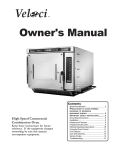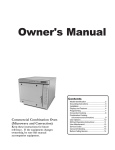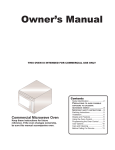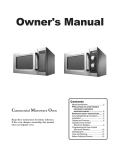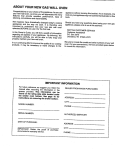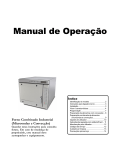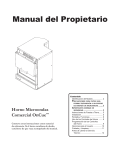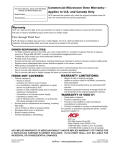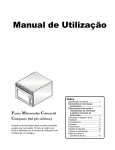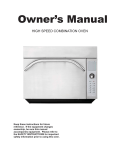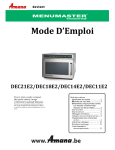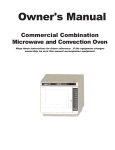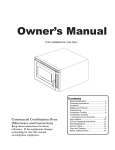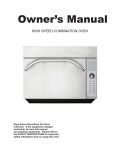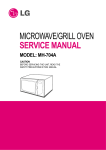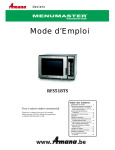Download warning
Transcript
_______________________________________ Training Manual R AF T Combination Microwave/Convection Ovens D ACE5140 P1333203M DS1400E P1333204M UCA1400 P1333205M 50 Hz Combi October, 2008 16400001 Table of Contents Commercial Microwave Technical Information ............................................................. Page 2 Quick Start Reference Guide ......................................................................................... Page 3 Disassembly Procedures Touch Panels/Displays/Triacs .................................................................................. Page 5 H.V.Board/I.S. Module ............................................................................................. Page 5 Back Panel .............................................................................................................. Page 6 Door ......................................................................................................................... Page 6 Stirrer Assembly ...................................................................................................... Page 7 Heater Assembly ..................................................................................................... Page 7 Component Testing Procedures................................................................................... Page 8-11 Power Test (Traditional) ......................................................................................... Page 12 Service Mode............................................................................................................ Page 13-15 Test Modes Convection Temperature Test ................................................................................ Page 16 Convection Temperature Calibration ..................................................................... Page 16 Calibration ............................................................................................................. Page 16 Display Diagnostics ....................................................................................................... Page 17 Wiring Diagram .............................................................................................................. Page 18 Schematic ...................................................................................................................... Page 19 Owners Manual .................................................................................................... Page 20 User Maintenance.................................................................................................... Page 31 Care and Cleaning .................................................................................................... Page 32 Before Calling for Service .................................................................................................... Page 33 Warranty 1 year - Parts, Labor, Travel 3 years - Magnetron (Part Only) 1 Commercial Microwave Technical Information ACE5140 / DS1400E / UCA1400 All safety information must be followed as provided in Service Manual. ! WARNING To avoid the risk of electrical shock, personal injury or death; disconnect power to oven and discharge capacitor before servicing, unless testing requires power. Models ACE5410 DS1400E Power Source Voltage AC Amperage (Single Unit) Frequency Single Phase, 3 wire grounded Plug Power Output − Microwave Nominal microwave energy (IEC705) Minimum temperature rise (∆T) Operating Frequency Power Consumption Microwave only Convection only Combination Dimensions Cabinet (in / cm) Width Height Depth Oven Interior (in / cm) Width Height Depth Weight Crated Uncrated UCA1400 230 VAC 16 A 50 Hz X CEE 7/7 Schuko 230 VAC 16 A 50 Hz X BS1363A 1400 Watts 10ºF / 5ºC 2450 MHz 1400 Watts 10ºF / 5ºC 2450 MHz 1400 Watts 2700 Watts 3400 Watts 1400 Watts 2700 Watts 3400 Watts 49 cm 46 cm 67 cm (19 1/4") (18 1/4") (26 1/4") 49 cm 46 cm 67 cm (19 1/4") (18 1/4") (26 1/4") 33 cm 27 cm 38 cm (13") (10 1/2") (15") 33 cm 27 cm 38 cm (13") (10 1/2") (15") 46 kg. 43 kg. (102 lbs.) (95 lbs.) 46 kg. 43 kg. (102 lbs.) (95 lbs.) 2 Quick Start Reference Guide Refer to Product Safety Manual for Safety Statements Complete Owner’s Manual available online Oven Wall Clearances A B C A—For North American (UL/CSA) models, allow at least 2” (5.1 cm) of clearance around top of oven. For International (50 Hz) models, allow at least 7” (17.8 cm) of clearance around top of oven. Proper air flow around oven cools electrical components. With restricted air flow, oven may not operate properly and life of electrical parts is reduced. B—Allow at least 2 9/16” (6,5 cm) between air discharge on back of oven and back wall. C—Allow at least 1 1/4” (3 cm) of clearance around sides of oven. The switching operation of this microwave oven can cause voltage fluctuations on the supply line. The operation of this oven under unfavorable voltage supply conditions can have adverse effects. This device is intended for the connection to a power supply system with a maximum permissible system impedance Zmax of 1.1 Ohm at the interface point of the user’s supply. The user has to ensure that this device is connected only to a power supply system which fulfills the requirement above. If necessary, the user can ask the public power supply company for the system impedance at the interface point. So...how do I use it? Manual Operation To cook food using a specific entered time and power level. 1. Press Preheat On/Off pad to start the oven. • Oven Preheating 450°F (230°C ) displays withOven Preheating flashing. (example of 450°F (230°C) shown 2. Oven reaches preheat temperature. • Signal sounds and Ready 450°F(230°C) displays. (example of 450°F (230°C) shown) 3. Press Time Entry pad. • Enter desired cooking time by using numeric keypad. 4. Press Temp Entry pad if cooking temperature differs from preheat temperature. • Enter the new temperature. 5. Press Power Level pad. • Press numeric key pad for desired level. Press numeric key pad again to set power level to 100%. • For a lower microwave power, press pads 1 (for 10%) through 9 (for 90%). 0 turns off the microwave power and cooking is by convection only. 6. If stage cooking is desired, press STAGE pad and repeat steps 3, 4, and 5. • Up to 4 different stages can be programmed. 7. Press the Start pad to begin the cooking cycle. Programming Items No popcorn Programming Preheat Setting The factory default preheat setting is 450°F (230°C). To program the preheat setting oven must be ON: 1. Press Program Save pad. 2. Press Temp Entry pad. 3. Enter desired temperature by using the numeric key pads. 4. Preheat temperature is changed. Preprogrammed Pads To cook food using preprogrammed cooking sequences. 1. Open oven door and place food in oven. Close door. 2. Press desired pad. 3. Oven begins to cook. 4. At end of cooking cycle oven beeps and shuts off. 1. Oven must be ON. • Press Preheat On/Off. • Oven Preheating 450°F (230°C) displays with Oven Preheating flashing. (example of 450°F (230°C) 2. Oven reaches preheat temperature. • Signal sounds and Ready 450°F (230°C) displays with Ready flashing. (example of 450°F (230°C) shown) 3. Press Program Save pad. 4. Press pad to be programmed or reprogrammed. 5. Press Time Entry pad to program amount of cooking time. • The total microwave cooking time (all stages combined) is 20 minutes. 6. Press Temp Entry pad to program the cooking temperature. • Enter desired temperature by using numeric pads. 7. Press Power Level pad to program level of microwave power. • Press numeric key pad for desired level. Press numeric key pad again to set power level to 100%. • For a lower microwave power, press pads 1 (for 10%) through 9 (for 90%). 0 turns off the microwave power and cooking is by convection only. 8. Press Stage pad. • Enter cook time, temp and power level as in steps 4. 5 and 6. • To enter another cooking stage for that pad, press Stage pad again. Up to four different stages can be programmed. 9. Press the Program Save pad to save the program and changes. NOTE: To discard changes, press Stop/Reset pad before pressing Program Save pad. 3 Quick Start Reference Guide Refer to Product Safety Manual for Safety Statements Complete Owner’s Manual available online Cleaning Teflon Coated Oven Cavity (some models) • Wear protective rubber gloves when cleaning oven. • Use only a plastic utensil or nylon scouring pad to aid in removing soil or build-up from the oven interior. • Do not use knife, metal utensil, or steel wool pad to remove baked on material. This will damage the teflon coating. • Refer to warranty for limitations regarding teflon interior and cleaning requirements. ? Can I change an option? Options such as single or double pad programming, beep volume, and maximum cooking time can be changed to suit individual preferences. To change options oven STANDBY must display: 1. Press hidden pad. • Pad is unmarked and located to the direct left of Preheat On/Off pad. • Nothing will be displayed when hidden pad is pressed. 2. Press Program Save pad. • The first user option will display. Oven is now in options mode. 3. Press number pad that controls option to be changed. • See table below for options. • Current option will display. 4. Press numeric pad again to change the option. • Each time pad is pressed, option will change. • Match code displayed with code for desired option. 5. Press Program Save pad to save changes. • To change additional options, repeat steps 3 and 4. • Changes take affect after Program Save pad is pressed. • Press Stop/Reset to return to STANDBY, or open and close oven door. DO NOT power spray Numbered Pads Display 1 Double Digit Entry 2 Manual Time Entry 3 Reset on Door Open 4 Keybeep Disabled Enabled Disabled Enabled Disabled Enabled Disabled Enabled OFF LOW MEDIUM HIGH Solid Beep 3 Second Beep 4 Beeps Once 4 Beeps Repeating 15 SECONDS 30 SECONDS 60 SECONDS 120 SECONDS ALWAYS Disabled Program Temp Cavity Temp Both Degrees F Degrees C Disabled Weekly Monthly Quarterly 5 Keybeep Volume 6 End of Cook Signal 7 Keypad Active 8 Preheat Warnings TEMP PAD Temperature Scale CLEAN FILTER Message Frequency Options (Factory Settings in Bold) Allows 10 (0-9) preprogrammed pads. Allows 100 (00-99) preprogrammed pads. Manual time entry/cooking not allowed Manual time entry/cooking allowed Opening oven door does not reset oven back to ready mode Opening oven door resets the oven back to ready mode Keys do not beep when pressed (keybeep off) Keys beep when pressed (keybeep on) Keybeep volume OFF Keybeep volume LOW Keybeep volume MEDIUM Keybeep volume HIGH Food done signal is a continuous beep until reset by user Food done signal is a three second beep Food done signal is four beeps, continuously. Food done signal is four beeps, four times Keypad time entry window is 15 seconds Keypad time entry window is 30 seconds Keypad time entry window is one minute Keypad time entry window is two minutes Keypad time entry window is always active Both temperature warnings off Warning only when preheat temperature does not match preprogrammed temperature Warning only when actual oven cavity temperature is not to preheat temperature Both temperature warnings on Temperatures are displayed in °F for 60 Hz models Temperatures are displayed in °C for 50 Hz models Oven will not display Clean Filter Oven will display Clean Filter every seven (7) days Oven will display Clean Filter every thirty (30) days Oven will display Clean Filter every ninety (90) days For full product documentation visit: www.amanacommercial.com 4 Disassembly procedures ! WARNING To avoid risk of electrical shock, personal injury or death; disconnect power to oven and discharge capacitors before following any disassembly procedures. Component Location Touch Panel (Top) Touch Panel (Side) Plug Triac #2 Heating Element Triac #3 Microwave Data Key Board Figure 1 Touch Panels/Displays/Triacs Fan Blade High Voltage Components Magnetron Line Filter Fuse Block Capacitor Fuse H.V. Board Rack Support Filter Interlock Switch Assembly Figure 2 H.V. Board/I.S. Assembly 5 Disassembly procedures ! WARNING To avoid risk of electrical shock, personal injury or death; disconnect power to oven and discharge capacitors before following any disassembly procedures. Magnetron Inlet Cover High Voltage Components Waveguide Duct Control Thermal Cutouts Heater Box Capacitors Relay Magnetron Thermal Cutout Diode High Voltage Transformer Fold diagram and place against blower br nge prior to assembling access panel. Figure 3 Back Panel Inner Door Assembly Figure 4 Door 6 Disassembly procedures ! WARNING To avoid risk of electrical shock, personal injury or death; disconnect power to oven and discharge capacitors before following any disassembly procedures. Stirrer Shaft Stirrer Blade Stirrer Insert Stirrer Cover Stirrer Cover Mounting Clip Figure 5 Stirrer Assembly NOTE: Thermal Cutouts Torque to .56 Newton-Meters Convection Fan Blade Rear Convection Fan Blade Front Convection Motor Single Heating Element Fan Blade Heater Box Torque to .56 Newton-Meters Left Handed Nut Figure 6 Heater Assembly 7 Component Testing Procedures ! WARNING To avoid risk of electrical shock, personal injury or death; disconnect power to oven and discharge capacitors before following any disassembly procedures. Illustration Component Thermal cutout 31866P01 ............... Test Disconnect all wires from TCO. Measure resistance across terminals. Oven TCO . ............................................ B5684123 .............. Fan TCO . ............................................ B5684121............... Diode Magnetron TCO........................................ Reverse leads for second test. MT1 Disconnect wires to triac. Measure resistance from: MT1 to MT2 .............................................. MT1 to Gate.............................................. MT2 GA TE Triac 1 (top) is for motors Triac 2 (middle) is for heater element Triac 3 (bottom) is for microwave Capacitors – 0.65 µf MT2 to Gate.............................................. All terminals to ground.............................. Voltage check measure voltage from: MT1 to Gate.............................................. Discharge Capacitor Remove wires from capacitor terminals and connect ohmmeter, set on highest resistance scale to terminals. Snubber assembly Open at 300 °F (149 °C) and closed at 257 °F (125 °C) Open at 350 °F (177°C) and closed at 17 °F (-8°C) Open at 280 °F (137°C) and closed at 180 °F (82°C) Discharge Capacitor Remove diode lead from capacitor and connect ohmmeter. Triac Results in one direction and 50KΩ or more in the opposite direction. NOTE: Ohmmeter must contain a battery of 6 volts minimum. Caution - Do not operate oven with wire to terminal MT2 removed. Approximately 60 Ω 0.8 VAC when energized. If no voltage, check H.V. board and wiring. Between Terminals: Meter should momentarily return to over 5 M Ω occurs, replace capacitor. Also check between each terminal and capacitor case. Disconnect wires to snubber. Measure resistance across terminals .......... Magnetron Discharge Capacitor Between Terminals: Less than 1 Ω Remove wires from magnetron and connect ohmmeter to terminals. Also check between each terminal and ground. Each terminal to ground measures Microwave blower motor Remove all wires from motor. Power relay Coil voltage – unit running Terminal 0 to 1.......................................... Coil resistance Terminal 0 to 1.......................................... Measure resistance across coil. 8 Note: This test is not conclusive. If oven does not heat and all other components test good replace the magnetron and retest. Approximately 30 Ω (line voltage) 21 K Ω Component Testing Procedures ! WARNING To avoid risk of electrical shock, personal injury or death; disconnect power to oven and discharge capacitors before following any disassembly procedures. Illustration Component Transformer 6 5 Measure resistance from: 230 to COM .............................................. 230 to Ground.............................................. Terminal 5 to 6............................................. Terminal 4 to Ground................................... 4 COM 230 Interlock switch Door Closed 4 3 Secondary 5 Primary 7 8 Monitor 2 7 8 4 3 5 Convection blower motor With door open measure resistance from: Terminal 2 to 3............................................ Terminal 4 to 5............................................ Terminal 7 to 8............................................ Resistance thermal device (RTD) Line filter Brown Less than 1 Ω Approximately 60 - 70 Ω Indicates continuity Indicates continuity Indicates continuity Remove wires from motor. Measure resistance across terminals A and B ........................................ Approximately 20 Ω Disconnect wires from terminals. Measure resistance across heating element. Element IN Less than 1 Ω B Heating element assembly Blue Results Disconnect wires to switch. With door closed measure resistance from: Terminal 2 to 3............................................ Terminal 4 to 5............................................ Terminal 7 to 8............................................ 2 A Test Discharge Capacitor Remove all wires from terminals. Blue OUT Brown 2700 W ....................... Approximately 15 Ω Temperature Resistance 0°C (32 °F) .................................................... 24°C (75 °F) .................................................. 177 °C (350 °F) .............................................. 1000 Ω 1091 Ω 1654 Ω Disconnect wire from terminals. Measure resistance of the following terminals: Blue to Blue ...................................... <1 Ω Brown to Brown ................................ <1 Ω 9 Component Testing Procedures ! WARNING To avoid risk of electrical shock, personal injury or death; disconnect power to oven and discharge capacitor before servicing, unless testing requires power. Illustration Test Continuity is indicated as 100 Ω and below. Top touch panel Continuity is indicated as 100 Ω and below. High voltage board to display module harness Test continuity of wires. 1 Component Side touch panel Pad 1 2 3 4 5 6 7 8 9 0 Start Stop/Reset Pad Preheat Time Entry Temp Entry Power Level Stage Program Save Hidden Pad Results Trace 3&5 3&6 3&7 3&8 3&9 4&5 4&6 4&7 4&8 4&9 5&6 6&9 Trace 3&4 5&7 7&8 5&8 5&9 6&7 8&9 1 Wire harness 10 Indicates continuity Measurement Continuity Continuity Continuity Continuity Continuity Continuity Continuity Continuity Continuity Continuity Continuity Continuity Measurement Continuity Continuity Continuity Continuity Continuity Continuity Continuity Component Testing Procedures ! WARNING To avoid risk of electrical shock, personal injury or death; disconnect power to oven and discharge capacitor before servicing, unless testing requires power. H.V. board In straight convection mode, both elements operate simultaneously. In combination mode, the rear element will operate simultaneously with either the microwave or front element. Function Test Set-Up Meter Probe Placement Results Setting Input to H.V. board At H.V. board Volts J1 pin 1 (Black wire) Line voltage & J1 pin 2 (Red wire) Output to display Disconnect Volts J5 pin 1 & 7.4 VDC board J5 connector J5 pin 47 Function Cooling fan Convection motor Microwave Heater Test Set-Up Disconnect J2 connector Disconnect J2 connector Disconnect J4 connector Disconnect J4 connector Meter Setting Ohms Ohms Ohms Ohms Probe Placement J1 pin 1 (Black wire) & J2 pin 4 J1 pin 1 (Black wire) & J2 pin 3 J4 pin 4 & J4 pin 5 E6 & J4 pin 1 11 Results Test mode 5 off – no continuity Test mode 5 on – < 1 Ω Test mode 4 off – no continuity Test mode 4 on – < 1 Ω Test mode 3 off – no continuity Test mode 3 on – < 1 Ω Test mode 1 off – no continuity Test mode 1 on – < 1 Ω Power Test ! WARNING To avoid risk of electrical shock, personal injury or death; disconnect power to oven and discharge capacitor before servicing, unless testing requires power. Power Test All Amana and Menumaster microwave oven power outputs are rated using the IEC705 standards. Using the IEC705 test method requires precision measurements and equipment that is not practical to be performed in the field. Using the test shown below will indicate if the oven performance is satisfactory. Test equipment required: • • 1000 ml test container (Part # 12018801) and thermometer. Digital watch / watch with a second hand for use on ovens with electromechanical timers. Important Notes: • • • Low line voltage will cause low temperature rise / power output. Ovens must be on a dedicated circuit, properly grounded, and polarized. Other equipment on the same circuit may cause a low temperature rise / power output. This test and results are not a true IEC705 test procedure and are only intended to provide servicers with an easy means of determining if the microwave oven cooking output is correct. Procedure 1. Fill the test container to the 1000 ml line with cool tap water. NOTE: Water temperature should be approximately 60° F / 16° C. 2. Using the thermometer, stir water for five to ten seconds; measure, and record the temperature (T1). 3. Place test container of water in the center of oven cavity and close door. 4. Heat the water for a 33-second full power cycle. NOTE: Use a digital watch or a watch with a second hand for ovens with electromechanical timers. 5. At end of the cycle, remove test container. Using the thermometer, stir water for five to ten seconds and record temperature (T2). 6. Subtract the starting water temperature (T1), from the ending water temperature (T2) to obtain the temperature rise (∆T). 7. If the temperature rise (∆T) meets or exceeds the minimum, the test is complete. If the temperature rise (∆T) fails to meet the minimum temperature rise, test the line voltage to verify it is correct. Then repeat steps 1-6 making sure to change the water. If the temperature rise (∆T) fails to meet the minimum temperature rise again the oven will require service. Minimum Temperature Rise at Thirty -Three (33) Seconds Run Time ∆T (°F) Cooking Power Output ∆T (°C) 14° F ............. 1400 Cooking Power Output 7.5°C ........ 1400 12 service mode Accessing Service Mode Service Mode Pressing Hidden Pad, 1, 3, 5, 7, 9 while in Preheat is OFF Main Service Mode Menu Mode Name Entry Functional Description Display S 5 6 e 0 r v H i Z c e 2 M o 3 0 d e V Pad 1 Service Pad 1 Pressing Pad 1 while in Service Mode Calrod #1 and convection fan shall be toggled. When on, it shall run for 62 seconds. Mode Name Entry Functional Description Display C a l r o d A : m p s : O 1 N 2 Pad 3 Service Pad 3 Pressing Pad 3 while in Service Mode Magnetron #1 shall be toggled. When on, it shall run for 62 seconds. Mode Name Entry Functional Description Display M a 0 0 g : n 4 e 5 t r o n A # m p 13 1 s : : O 1 N 2 service mode Pad 4 Service Pad 4 Pressing Pad 4 while in Service Mode Convection Fan shall be toggled. Mode Name Entry Functional Description Display C o n v . A F a m p n s : : O 0 N 3 O N Pad 5 Service Pad 5 Pressing Pad 5 while in Service Mode Auxiliary Output shall be toggled. Mode Name Entry Functional Description Display A u x . O u t p u t : Pad 7 Service Pad 7 Pressing Pad 7 while in Service Mode Displays Tube Hours stored in EEPROM Mode Name Entry Functional Description Display M a g n e t 0 r 0 o 1 n 7 4 14 H 3 o u r S service mode Pad 8 Service Pad 8 Pressing Pad 8 while in Service Mode Displays Door Cycles stored in EEPROM. Will always be a multiple of ten. Mode Name Entry Functional Description Display D o o 0 r 0 2 C 4 y 5 c 3 l 8 e 0 s Pad 9 Service Pad 9 Pressing Pad 9 while in Service Mode Prompts user to clear service information. Mode Name Entry Functional Description Display P C r l e e s a s r S s T e A r R v T . t i o n f Pad 0 Service Pad 0 Pressing Pad 0 while in Service Mode Displays offset used when heating cavity. Mode Name Entry Functional Description Display T e m p . 2 0 O ° f C f s e T TEMP Pad Display Temperature Pressing the Temp Pad in Service Mode. Displays temperature as reported by RTD Mode Name Entry Functional Description Display C a v i 1 t 9 y 4 ° T C e m P 15 o Test modes ! WARNING To avoid risk of electrical shock, personal injury or death; disconnect power to oven and discharge capacitors before following any disassembly procedures. Convection Temperature Test Convection Temperature Calibration NOTE: It is absolutely necessary to own and use a thermocouple type oven tester to accurately measure oven temperatur e. No other type of thermometer can take its place. NOTE: It is normal for the average oven temperature to vary from the oven setting by as much as C mind. NOTE: Before testing an oven to check calibration, inspect the RTD for proper mounting. Calibration 1. Place one wire rack in center position. Remove any other racks and utensils. 2. Clip thermocouple to the center rack and run lead outside oven door, or wrap thermocouple around rack and have the tip of thermocouple extend upward towards top of cavity approximately 1". 3. Press PREHEAT ON/OFF pad. 4. Press PROGRAM SAVE pad. 5. Press TEMP pad. 6. Enter 230°C. 7. Allow oven to cycle one time. 8. Record high and low peaks from next two cycles. NOTE: Door must be closed and unit must be in STANDBY mode. 1. Press HIDDEN PAD. 2. Press pads 1,3,5,7, 9. 3. Press "0" pad. ITEM STG QTY C M LMT 1 2 3 4 1 Cycle 2 879°F NOTE: 921°F = 1800°F NOTE: Cycle 2 230°C 460°C NOTE: HIGH 240°C LOW 230°C 240°C + and advances in 1 and 2° increments. 5. Press STOP/RESET Celsius Example: 1 COOK LEVEL Celsius 1800°F / 4 = 450°F average temperature Cycle STANDBY and advances in 2 and 3° increments. 461°F + READY Fahrenheit HIGH 460°F 439°F NOT 4. Press the "0" Fahrenheit Example: Cycle PREHEAT NOTE: NOTE: Display does not indicate if heating elements LOW 440°F POWER made. Fahrenheit Example: • Oven temperature is set for 450°F • Average of temperature test is 475°F • • is shown in the display (10 – 25 = –15) 480°C = 940°C 940°C / 4 = 235°C average temperature If the average temperature is too high or too low the Celsius Example: • Oven temperature is set for 230°C • Average of temperature test is 240°C • • shown in the display (5– 10= –5) 16 DISPLAY DIAGNOSTICS Error Codes: During operation, the display may show the following service codes: Note: Before scheduling service for any error codes, instruct customer to unplug oven for 1 minute, reconnect power, and re-test. If unit operates properly, no service call is required. DESCRIPTION CORRECTIVE ACTION Error 1U Chassis Memory Not Found Error 1F Error 2 Chassis Memory Not Programmed Failed H.V. Board Error 3 Failed H.V. Board Error 4 Failed H.V. Board Error 5 Shorted Touch Panel Error 6 Error 7-O Error 7-S Door Open Options Scrambled Open RTD Shorted RTD Door Interlock Primary Switch Error Oven to Hot Control TCO Open -Check EZ Card Harness -Replace EZ Card Board -Unplug Oven and Re-Plug In -Replace H.V. Board -Replace H.V. Board -Replace Touch Panel -Replace H.V. Board -Replace Touch Panel -Replace H.V. Board -Incorrect H.V. Board Installed in Oven Note: If touch panel is pressed for more than 30 seconds, this error code will appear. -Disconnect Oven From Power Supply -Disconnect Side Touch Panel Connector From Display Board. -Reconnect Oven to Power Supply -If “Err5” Reappears After 30 Seconds, Replace Top Touch Panel. -If “Err5” Does Not Reappear After 30 Seconds, Replace Side Touch Panel. Replace H.V. Board Check RTD and Wiring to H.V. Board Check RTD and Wiring to H.V. Board -Verify Latch Mechanism Moves Freely On Door. -Verify J1 Connector On Display Board Is Properly Seated. -Test Interlock Switch Assembly and Perform Door Adjustment If Necessary. -Replace Interlock Switch Assembly. -Check Fan Blade. DISPLAY -Check Airflow. -Fan Motor not Operating. 17 2 BK-8 BK-8 6 8 1 F 15A XFMR FUSE 5 4 8 7 BK-9 3 2 WH-17 WH-14 BU-16 FA MAGNETRON MAG TCO INTERLOCK SWITCH PK-38 GN-37 RD-15 RD-23 4 BK-24 BK-18 0 BK-18 YL-28 BK-37 RD-15 BU-16 WH-17 COM 230 5 4 HV WH-14 POWER TRANSFORMER 6 RD-19 RD-20 2 G RECTIFIER BK-36 YL-28 BU-35 VT-29 CAPACITOR CAPACITOR MAGNETRON TRIAC (TR3) (BOTTOM) 1 2 G HEATER TRIAC (TR2) (TOP) 1 VT-32 YL-31 POWER RELAY BK-37 RD-13 CONVECTION MOTOR GY-3 GN-37 VT-29 VT-7 LOWER SWITCH J5 HEATER J1 DISPLAY BOARD J4 UPPER SWITCH J6 J2 RD-12 BLOWER MOTOR GN/YL YL-6 PK-38 BR BU LINE FILTER BR BU BR BU BR BU A B C D WH TERMINAL BLOCK E6 E7 J7 J10 J6 J11 POWER CORD OVEN TCO BR RD J8 VT-7 BK-22 GN/YL BK-4 VT-32 BU-35 YL-31 BK-36 BK GN WH RD GN LIMITER BU BK-4 RD-1 BR BU GN BK 15A LINE FUSE SHIELDED CABLE BR BR RD-5 J4 POWER BOARD J5 RD-20 J3 E3 E1 E5 E4 J2 J1 E2 RD23 GY-3 YL-6 RD-12 COLOR CODE RED RD PINK PK ORANGE OR YELLOW YL GREEN GN BLUE BU VIOLET VT BLACK BK BROWN BR GRAY GY WHITE WH RD-5 OR-25 BR-2 RD-19 BK-26 BK-26 BK-22 RD-13 BK-9 WIRE CODE HIGH VOLTAGE LOW VOLTAGE BK-24 18 BR-2 RTD OR-25 WIRING DIAGRAM PART NO. 13070304 Wiring diagram schematic L1 GND 230V 50HZ L2 SCHEMATIC CONDITION: DOOR OPEN LINE FILTER GND SHIELDED CABLE OVEN TCO P2 20A FUSE UPPER KEYBOARD DATA KEY BOARD E2/E3 E1 P1 J6 J4 CURRENT SENSE J8-1 J5 POWER BOARD J6 J8-2 J5 J8-3 J8-4 4 INTERLOCK (PRIMARY) 5 J1-1 J8-7 J8-6 LOWER KEYBOARD SHIELDED CABLE J1-1 J1-3 DISPLAY BOARD J1-2 T RTD K1 LIMITER J2-4 M1 COOLING FAN K2 J2-3 M2 CONVECTION FAN K3 J7-5 K9 E6/E7 TRIAC (2) HEATER (TOP) J4-1 J7-4 T2 G POWER BOARD T1 HEATER K4 E4/E5 J3-3 0 POWER BOARD P OWE R R E L AY 2 1 3 6 INTERLOCK (SECONDARY) POWER RELAY 8 7 8 INTERLOCK (MONITOR) J4-4 4 K7 J4-5 2 POWER RELAY J7-3 J7-2 POWER BOARD MAGNETRON TCO 15A FUSE TRIAC (3) MAGNETRON (BOTTOM) POWER TRANSFORMER 230 T2 G POWER BOARD T1 COM 6 5 CAP CAP CAP RES INTERLOCK SWITCH SCHEMATIC DOOR CLOSED DANGER HIGH VOLTAGE RECTIFIER 2 3 SECONDARY 4 5 PRIMARY 7 8 MONITOR CAUTION: FA F MAGNETRON 19 DO NOT REMOVE WIRE FROM TRIAC TERMINAL T2 DURING TESTING. THIS WILL CAUSE HV BOARD TO SHORT OUT Owner's Manual Contents Model Identifi cation ................................... 21 Grounding Instructions ............................... 22 Installation ................................................. 22 Display and Features ................................. 23 Programming ............................................. 26 Convection Cooking ................................... 27 Combination Cooking (microwave and convection) .................... 28 User Options ............................................ 29 EZCard Operating Instructions ................. 30 User Maintenance .................................... 31 Service Codes .......................................... 31 Care and Cleaning .................................... 32 Before Calling Service .............................. 33 Commercial Combination Oven (Microwave and Convection) Keep these instructions for future reference. If the equipment changes ownership, be sure this manual accompanies equipment. 20 Model Identification When contacting Amana, provide product information. Product information is located on oven serial plate. Record the following information: Model Nu mber: ____________________________ Serial or S/N Number: _______________________ Date of installation: _________________________ Dealer’s name and address: __________________ ________________________________________ ________________________________________ Any questions or to locate an authorized Amana servicer, call Amana ComServ Service Support. – Inside the U.S.A. or Canada, call toll-free at 866-4262621. – Outside the U.S.A. and Canada, call 319-368-8120. – Email: [email protected]. Warranty service must be performed by an authorized Amana servicer. Amana also recommends contacting an authorized Amana servicer, or Amana ComServ Service Support if service is required after warranty expires. 21 Installation Unpacking Oven • • • • Inspect oven for damage such as dents in door or inside oven cavity. Report any dents or breakage to source of purchase immediately. Do not attempt to use oven if damaged. Remove all materials from oven interior. If oven has been stored in extremely cold area, wait a few hours before connecting power. ! WARNING To avoid risk of electrical shock or death, this oven must be grounded and plug must not be altered. Radio Interference Microwave operation may cause interference to radio, television, or a similar oven. Reduce or eliminate interference by doing the following: • Clean door and sealing surfaces of oven according to instructions in Care and Cleaning section. • Place radio, television, etc. as far as possible from oven. • Use a properly installed antenna on radio, television, etc. to obtain stronger signal reception. Oven Placement • • • • • Do not install oven next to or above source of heat, such as pizza oven or deep fat fryer. This could cause microwave oven to operate improperly and could shorten life of electrical parts. Do not block or obstruct oven filter. Allow access for cleaning. Install oven on level countertop surface. If provided, place warning label in a conspicuous place close to microwave oven. Outlet should be located so that plug is accessible when oven is in place. A B C A—For North American (UL/CSA) models, allow at least 2” (5.1 cm) of clearance around top of oven. For International (50 Hz) models, allow at least 7” (17,8 cm) of clearance around top of oven. Proper air flow around oven cools electrical components. With restricted air flow, oven may not operate properly and life of electrical parts is reduced. B—Allow at least 2 9/16” (6,5 cm) between air discharge on back of oven and back wall. C—Allow at least 1 1/4” (3 cm) of clearance around sides of oven. Oven Clearances The switching operation of this microwave oven can cause voltage fluctuations on the supply line. The operation of this oven under unfavorable voltage supply conditions can have adverse effects. This device is intended for the connection to a power supply system with a maximum permissible system impedance Zmax of 1.1 Ohm at the interface point of the user’s supply. The user has to ensure that this device is connected only to a power supply system which fulfills the requirement above. If necessary, the user can ask the public power supply company for the system impedance at the interface point. 22 Earthing Instructions Oven MUST be grounded. Grounding reduces risk of electric shock by providing an escape wire for the electric current if an electrical short occurs. This oven is equipped with a cord having a grounding wire with a grounding plug. The plug must be plugged into an outlet that is properly installed and grounded. Consult a qualified electrician or servicer if grounding instructions are not completely understood, or if doubt exists as to whether the oven is properly grounded. Do not use an extension cord. If the product power cord is too short, have a qualified electrician install a three-slot receptacle. This oven should be plugged into a separate circuit with the electrical rating as provided in product specifications (available on Amana’s wavelink website). When the combination oven is on a circuit with other equipment, an increase in cooking times may be required and fuses can be blown. External Equipotential Earthing Terminal (export only) Equipment has secondary earthing terminal. Terminal provides external earthing connection used in addition to earthing prong on plug. Located on outside of oven back, terminal is marked with symbol shown below. Display and Features B C D A E G A—Oven Door Handle (Lift to open.) B—Rack Guides C—Top Control Panel D—Display E—Side Control Panel G—Air Intake Filter (some models) Oven Features Standby shows in display after oven door has been opened and closed, or after turning oven OFF with the Preheat On/Off pad. Standby Oven Preheating 230°C Oven Preheating and set temperature shows in display after pressing Preheat On/Off pad. (example of 230°C shown) 23 Display and Features Ready and set temperature displays after pressing Preheat On/Off pad. Ready indicates the oven is up to temperature. (example of 230°C shown) (cont’d) Ready 230°C Indicates oven is in a preprogrammed cooking program Item-05 Stage:1 01:23 230°C MW:50% Time left in cooking program Cooking temperature Cooking information shows in display after pressing a single (or double) digit pad while in Ready Mode. Percentage of microwave power Indicates oven is in a manual cooking program Manual Stage: 1 00:15 246°C MW:100% Time left in cooking condition 24 Cooking temperature Indicates percentage of microwave power Display and Features Start pad The Start pad is used to begin a manual time entry cooking cycle. Stop/Reset pad The Stop/Reset pad stops a cooking sequence in progress, clears out any remaining time, and also ends a programming or user option cycle. When the Stop/Reset pad is used to end a programming or option change, the changes are discarded. Temperature warnings The combination oven has two distinct temperature warnings. Warnings sound with a three beep signal when a programmed pad is pressed. Warnings are: • • A warning when the preheat temperature does not match the preprogrammed temperature of a cooking condition. A warning when the actual oven cavity temperature is not to preheat temperature, such as when the oven is first started. To override the warning and begin a cooking cycle, press the Start pad. To turn off warnings, see User Options section. (cont’d) Cooking Display DISPLAYS DESCRIPTION OVEN PREHEATING 230°C Oven Preheating 230°C displays when oven turned on and is warming up to the selected preheat temperature. Oven Preheating also flashes when a cooking condition can be started programmed. (example of 230°C shown) READY 230°C Ready 230°C displays when oven has reached preheat temperature and is ready to cook. Read also flashes when a cooking condition can be started or programmed. (example of 230°C shown) 00:00 Displays cooking time. If stage cooking is programmed, total cooking time is displayed. MW 50% MW 50% displays the current microwave power level. 100% is the hi ghest setting , and 0% is low (no microwave energy used). (example of 50% shown) ITEM-05 ITEM-05 displays the single or double digit entry of a pro grammed cooking condition when using a programmed pad. (example of Item 05 shown) STAGE 1 Stage 1 displays to show the stage number (1 through 4) the oven is at in the cooking condition STANDBY STANDBY displays when oven is turned off, and also after the oven is plugged in, the door is opened, and then shut. Programming Display DISPLAYS DESCRIPTION Enter Program to Add/Review: Displays when oven is in programming mode for single pad or double pad memory. STAGE 1 Displays stage number during cooking or when programming a specific cooking stage. Stage number (1 through 4) indicates the stage that is being used. 25 Programming Programming Pads Oven is shipped from the factory for single pad programming. To change the oven default to double pad programming, see User Option section. To program the amount of time, power level, or temperature setting for a pad: 1. Oven must be ON. • Press Preheat On/Off pad. • Oven Preheating 230°C shows in display with Oven Preheating flashing. (example of 230°C shown) 2. Oven reaches preheat temperature. • Signal sounds and Ready 230°C shows in display with Ready flashing. (example of 230°C shown) 2. Press Program Save pad. • Programming mode begins. • Enter Program to Add/Review: shows in display. 3. Press pad to be programmed or reprogrammed. • Display will change to review all settings for the pad. • The pad number that is being programmed displays beside the word ITEM . 4. Press Time Entry pad to program amount of cooking time. • Enter desired cooking time by using numeric key pads. • The total microwave cooking time (all stages combined) is 20 minutes. 5. Press Temp Entry pad to program the cooking temperature. • Enter desired convection temperature by using numeric pads. 6. Press Power Level pad to program level of microwave power. • Press numeric key pad for desired level. Press numeric key pad again to set power level to 100%. • For a lower microwave power, press pads 1 (for 10%) through 9 (for 90%). 0 turns off the microwave power and cooking is by convection only. 7. Press Program Save pad to save the program changes. 8. To discard changes, press Stop/Reset pad. Programming Multiple Stages Stage cooking allows consecutive cooking cycles without interruption. Up to four different cooking cycles can be programmed into a memory pad. To use stage cooking: 1. Follow steps 1 through 6 above. 7. Press Stage pad. • This will begin programming for the next cooking stage. • Display indicates stage to be programmed. • Enter cook time, temp and power level as in steps 4. 5 and 6. • To enter another cooking stage for that pad, press Stage pad again. • Up to four different stages can be programmed. 8. Press Program Save pad to save the program and changes. 9. To discard changes, press Stop/Reset pad before pressing Program Save pad. 26 Programming Preheat Setting The convection temperature setting can be set between 150°F to 475°F (65°C to 250°C). It is recommended to set the preheat setting to the most commonly used temperature for that oven. The factory default preheat setting is 450°F (230°C). To program the preheat setting : 1. Press Program Save pad. 2. Press Temp Entry pad. 3. Enter desired temperature by using the numeric key pads. • Temperature must be entered in 25°F (10°C) increments. If not, the temperature will automatically change to the nearest 25°F (10°C). 4. Preheat temperature is changed. What is stage cooking? Stage cooking enables several different cooking cycles, or stages, to be used consecutively without repeated input from the user. Stage cooking can be set to defrost food initially, then cook it, and then keep the food warm until serving time. Convection Cooking ! CAUTION To avoid risk of burns, handle utensils, racks, and door with care. Allow oven, utensils, and racks to cool before cleaning. Oven, utensils, and racks, become hot during operation. To operate the oven for convection cooking only, you can use preprogrammed pads or manual time entry. The following instructions are for convection cooking only. For combination cooking, see that section. Convection Cooking with Programmed Pads Convection Cooking Convection cooking utilizes both a convection element and fan to evenly distribute heated air throughout the oven cavity. By circulating air, no hot or cold spots occur, creating a consistent temperature envelope around the food. These consistent temperatures cook food evenly and reduces cooking time. Oven will always operate in convection mode. 1. Press Preheat On/Off pad to start the oven. • Oven begins a preheat cycle. • Oven Preheating 230°C shows in display. (example of 230°C shown) • To change preheat temperature, see Programming. 2. Oven reaches preheat temperature. • Signal sounds and Ready 230°C displays. 3. Press selected pad. • If using single pad programming, press pad and oven begins automatically. • For double pad programming, press pads in proper sequence and oven begins automatically. 4. Cooking cycle begins • Preprogrammed cooking program, total cooking time, cooking temperature, percentage of microwave power, and stage are all displayed. 5. Oven finishes cooking sequence • An end of cycle beep signals the end of the cooking cycle. • Done shows in display. • Oven interior and cooking dish will be hot. 6. Press Preheat On/Off pad to shut off oven. Convection Cooking Using Manual Cooking Operation 1. Press Preheat On/Off pad to start the oven. • Oven begins a preheat cycle. • Oven Preheating 230°C shows in display. (example of 230°C shown) • To change preheat temperature, see Programming . 2. Oven reaches preheat temperature. • Signal sounds and Ready 230°C displays. 3. Press Time Entry pad. • Enter desired cooking time by using the numeric keypad. 4. Press Temp Entry pad if cooking temperature differs from preheat temperature. • Enter the new temperature. 5. Press Power Level pad. • Press numeric key pad for desired level. Press numeric key pad again to set power level to 100%. • For a lower microwave power, press pads 1 (for 10%) through 9 (for 90%). 0 turns off the microwave power and cooking is by convection only. 6. If stage cooking is desired, press Stage pad and repeat steps 3, 4, and 5. • Up to 4 different stages can be programmed. 7. Press the Start pad to begin the cooking cycle. 27 Combination Cooking ! (microwave and convection) CAUTION To avoid risk of burns, handle utensils, racks, and door with care. Allow oven, utensils, and racks to cool before cleaning. Oven, utensils, and racks, become hot during operation. To operate the oven for combination cooking, you can use preprogrammed pads or manual time entry. The following instructions are for combination cooking only. For convection only cooking, see that section. Combination Cooking With Preprogrammed Pads 1. Press Preheat On/Off pad to start the oven. • Oven begins a preheat cycle. • Oven Preheating 230°C shows in display. (example of 230°C shown) • To change preheat temperature, see Programming. 2. Oven reaches preheat temperature. • Signal sounds and Ready 230°C displays. 3. Press selected pad. • If using single pad programming, press pad and oven begins automatically. • For double pad programming, press pads in proper sequence and oven begins automatically. 4. Cooking cycle begins • Preprogrammed cooking program, total cooking time, cooking temperature, percentage of microwave power, and stage are all displayed. 5. Oven finishes cooking sequence • An end of cycle beep signals the end of the cooking cycle. • Done shows in display. • Oven interior and cooking dish will be hot. 6. Press Preheat On/Off pad to shut off oven. Combination Cooking The combination mode uses both the speed of microwave energy and browning of convection cooking to yield fast, high quality food. • Microwave cooking uses high frequency energy waves to heat the food. When cooking, microwave energy causes food molecules to move rapidly. This rapid movement between the food molecules creates heat, which cooks the food. POWER displays when oven is generating microwave energy for the current cycle. • Convection cooking uses the selected oven temperature to bake and brown foods. The circulating air surrounds food in an envelope of evenly heated air. • Oven will maintain a minimum convection temperature of 65°C (150°F) to ensure drier air and more even cooking. Combination Cooking Using Manual Cooking Operation 1. Press Preheat On/Off pad to start the oven. • Oven begins a preheat cycle. • Oven Preheating 230°C shows in display. (example of 230°C shown) • To change preheat temperature, see Programming . 2. Oven reaches preheat temperature. • Signal sounds and Ready 230°C displays. 3. Press Time Entry pad. • Enter desired cooking time by using the numeric keypad. 4. Press Temp Entry pad if cooking temperature differs from preheat temperature. • Enter the new temperature. 5. Press Power Level pad . • Press numeric key pad for desired level. Press numeric key pad again to set power level to 100%. • For a lower microwave power, press pads 1 (for 10%) through 9 (for 90%). 0 turns off the microwave power and cooking is by convection only. 6. If stage cooking is desired, press Stage pad and repeat steps 3, 4, and 5. • Up to 4 different stages can be programmed. 7. Press the Start pad to begin the cooking cycle. 28 User Options Changing user options Didn’t like an option? Factory settings are marked in bold. To change the oven back to the factory setting, simply select the option that is marked in bold. ? My changes weren’t saved. In order for any changes to be saved, the Program Save pad must be pressed after selecting an option. Pressing the Stop/Reset pad will not save changes. Numbered Pads 1 Double Digit Entry 2 Manual Programming 3 Reset on Door Open 4 Keybeep 5 Speaker Volume Options such as single or double pad programming, beep volume, and maximum cooking time can be changed to suit individual preferences. To change options oven STANDBY must display: 1. Press hidden pad. • Pad is unmarked and located to the direct left of Preheat On/Off pad. • Nothing will be displayed when hidden pad is pressed. 2. Press Program Save pad. • The first user option will display. Oven is now in options mode. 3. Press number pad that controls option to be changed. • See table below for options. • Current option will display. 4. Press numeric pad again to change the option. • Each time pad is pressed, option will change. • Match code displayed with code for desired option. • To change additional options, repeat steps 3 and 4. • Changes take affect after pad is pressed. 5. Press Stop/Reset pad to return to STANDBY, or open and close oven door. Display Disabled Allows 100 (00-99) preprogrammed pads. Disabled Manual time entry/cooking not allowed Enabled Manual time entry/cooking allowed Disabled Opening oven door does not reset oven back to ready mode Enabled OFF 7 Keypad Active 8 Preheat Warning Opening oven door resets the oven back to ready mode Keys do not beep when pressed (keybeep off) ON Keys beep when pressed (keybeep on) OFF Keybeep volume OFF LOW Keybeep volume LOW MEDIUM Solid Beep 6 Allows 10 (0-9) preprogrammed pads. Enabled HIGH End of Cook Signal Options (Factory Settings in Bold) 3 Second Beep 4 Beeps Once Keybeep volume MEDIUM Keybeep volume HIGH Food done signal is a continuous beep until reset by user Food done signal is a three second beep Food done signal is four beeps, continuously 4 Beeps Repeating Food done signal is four beeps, four times 15 SECONDS Keypad time entry window is 15 seconds 30 SECONDS Keypad time entry window is 30 seconds 60 SECONDS Keypad time entry window is one minute 120 SECONDS Keypad time entry window is two minutes ALWAYS Keypad time entry window is always active Disabled Both temperature warnings off Program Warning Only Warning only when preheat temperature does not match preprogrammed temperature Preheat Warning Only Warning only when actual oven cavity temperature is not to preheat temperature Both Both temperature warnings on TEMP PAD FAHRENHEIT Temperature Units CELSIUS Temperatures are displayed in °C for 50 Hz models Disabled Oven will not display Clean Filter Weekly Oven will display Clean Filter every seven (7) days Monthly Oven will display Clean Filter every thirty (30) days Quarterly Oven will display Clean Filter every ninety (90) days STAGE PAD Clean Filter Message (Frequency) Temperatures are displayed in °F for 60 Hz models 29 EZCard Operating Instructions (some models) Update programs in seconds! EZCard slot To program the oven using the EZCard: Oven must be in Standby mode (Preheat must be OFF) 1. Remove protective cover from bottom of vertical keypad. 2. Insert the EZCard into the slot located below the vertical keypad. • The EZCard can be inserted forwards or backwards. 3. Press and hold the Program Save pad for 3 seconds. • AUTO , then PROG displays briefly, repeating this sequence every second as the EZCard automatically programs the oven. • When the oven programming is complete, DONE shows in the display for 3 seconds and the oven beeps. • The oven resets to the standby mode. 4. Remove the EZCard. • The oven programming is now complete. 5. Place protective cover back over slot in bottom of control panel. Caution: DO NOT REMOVE EZCard while programming. Removing card during programming can cause the oven’s keypad to freeze up. STOP! EZCard NOTE: If 00:00 displays, 3 beeps sound and the display returns to the Standby mode, the EZCard was not detected. • Reinsert the EZCard into the slot and try each step again. • If after several attempts, the EZCard is still not detected, contact Amana ComServ Service Support. – Inside the U.S.A. or Canada, call toll-free at 866-426-2621. – Outside the U.S.A. and Canada, call 319-368-8120. – Email: [email protected]. Use this option only to transfer data from the oven TO the EZCard. This will overwrite all programming on the EZCard! To transfer programming from the oven to the EZCard: Oven must be in Standby mode (Preheat must be OFF) 1. 2. 3. 4. 5. 6. 7. Remove protective cover from bottom of vertical keypad. Insert the EZCard into the slot located below the vertical keypad. • The EZCard can be inserted forwards or backwards. Press the Program Save pad. Press the START pad. Press the 1 pad, the 3 pad, and then the 5 pad. • The programming transfer will begin automatically and the display will show moving dashes. • When the programming transfer is complete, DONE shows in the display for 3 seconds and the oven beeps. • The oven resets to the standby mode. Remove the EZCard. • The programming transfer is now complete. Place protective cover back over slot in bottom of control panel. 30 To order additional EZCards, call the Amana Commercial Inside Sales Team toll-free at 866-426-2621 (U.S.A. or Canada), or 319-368-8120 (outside the U.S.A. and Canada). User Maintenance Moving Oven Rack Guides (some models) The oven rack guides can be moved to one of three positions within the oven, allowing for versatility in cooking and placement of food. The middle rack position is the most common. Guides can also be removed for easier cleaning. To remove rack guides: 1. Oven cavity must be cool to touch. 2. Remove oven rack by lifting up and sliding to the front of the oven. 3. Apply gentle pressure by pulling upwards on the front of rack guide. 4. Lift the rear of the rack guide to remove. Guide may be snug. To replace rack guides: 1. Oven cavity must be cool to touch. • UP on guide rack should be in correct direction for placement. 2. Place rear of rack guide over desired anchor in back of oven and push down. 3. Place front of rack guide over desired anchor in front of oven. • Apply firm pressure to front and rear of rack guide to fit onto anchor. • Fit may be tight. • Rack guide should not move after being set in place. 4. Replace oven rack as desired. • Slide oven rack towards rear of oven, holding upwards to avoid detents. • Oven rack can be placed upwards or downwards. Upwards is recommended. • Oven rack must be seated in detents. Service codes During operation, the oven may display a service code. If this should occur: 1. Unplug oven and leave unplugged for approximately one minute. Plug oven in and see if code reappears. • If code does not reappear, continue normal use with the oven. 2. If service code reappears, write down the service code displayed and contact the nearest authorized Amana Servicer. • Do not use oven until contacting the Amana Servicer. 31 Error2 (example) Care and Cleaning Clean oven frequently to maximize oven life, performance, and efficiency. A dirty oven cooks inefficiently because moisture, spills, and grease absorb convection and microwave energy. ! ! WARNING To avoid electrical shock which can cause severe personal injury or death, unplug power cord or open circuit breaker to oven before cleaning oven. CAUTION To prevent burns, handle utensils, racks, and door with care. Allow oven, utensils, racks to cool before cleaning. Oven, utensils, and racks, become hot during operation. Cleaning the Oven Daily Cleaning Recommendations: Follow the recommendations below for proper maintenance of this oven. Please Note: The use of caustic cleaning products or those containing ammonia, phosphates or chlorine can damage critical oven parts and may void the warranty on those parts. Recommended Cleaning Supplies: Plastic scraper or plastic putty knife, scrub pad or nylon sponge safe for a non-stick finish such as a light duty scrub sponge. 1. Shut oven off by pressing the Preheat On/Off pad. Open oven door and allow oven to cool (approx. 60-90 minutes). 2. Remove rack, rack guides and accessories. Wash with warm, soapy water (except for pizza stone) and allow to air dry while cleaning oven interior. Clean pizza stone by using a plastic scraper and a damp cloth only. 3. Remove baked on particles from oven floor, rear, sides, and door by using a plastic scraper. When finished scraping, use a damp cloth to remove particles from oven. 4. With rubber gloves on, spray oven door, sides and floor with EcoLab Grease Cutter NC. Allow to soak for 5-10 min. Remove racks and rack guides for best results. Clean oven daily using EcoLab Grease Cutter NC or another noncaustic cleaner. DO NOT use caustic cleaning products or those containing ammonia, phosphates or chlorine. NOTE: A plastic putty knife or equivalent may be used to remove baked on debris. • • • • • • • • • Remove food from oven at end of cycle. Wear protective rubber gloves when cleaning oven. Use only a plastic putty knife, nylon scouring pad or equivalent, to aid in removing soil or build-up from the oven interior. Do not use knife, metal utensil, or steel wool pad to remove baked on material. This will damage the teflon coating. Refer to warranty for limitations regarding teflon interior and cleaning requirements. Use only accessories that are both high temperature oven-safe and microwave-safe in the oven. DO NOT use a water-pressure type cleaning system. DO NOT cook foods with plastic wrap on them. DO NOT use metal pans or foil in the oven. Recommended Maintenance Clean Heater Box (Not covered under warranty) • • Contact an authorized servicer to remove and clean heater box. Cleaning the heater box is recommended every 12 months or when heavy grease buildup is apparent on back of oven cavity. 32 Before Calling for Service ! WARNING To avoid electrical shock which can cause severe personal injury or death, do not remove outer case at any time. Only an authorized servicer should remove outer case. Problem Possible Cause Confirm oven is plugged into dedicated circuit. Oven does not operate. Confirm oven is on grounded circuit. (Contact electrician to confirm) Check fuse or circuit breaker. Oven operates intermittently or HOT shows in display. Check air filter and discharge areas for obstructions. If oven does not accept entries when pad is pressed. Make sure oven is on and preheated. Open and close oven door. Press pad again. If oven malfunctions or shows: Oven control is equipped with a self-diagnostic system. Self-diagnostic system alerts you if there is an error or problem. When electronic control signals a problem, follow steps listed below. Error2 (example) 1. Record number shown. (example of Error2 shown) 2. Unplug oven, wait for 1 minute, and plug in oven. • Disconnecting electrical supply may eliminate service code. If failure continues, contact an authorized servicer. Oven fan turns on while oven is not preheating or cooking. Normal operation. F or full product documentation visit: www.amanacommercial.com 33 50 hz Combi october 30, 2007 rev. 0




































